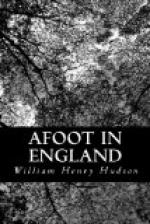It was, on this occasion, a great pleasure to listen to the doves. The stock-dove has no set song, like the ringdove, but like all the other species in the typical genus Columba it has the cooing or family note, one of the most human-like sounds which birds emit. In the stock-dove this is a better, more musical, and a more varied sound than in any other Columba known to me. The pleasing quality of the sound as well as the variety in it could be well noted here where the birds were many, scattered about on ledges and projections high above the earth, and when bird after bird uttered its plaint, each repeating his note half a dozen to a dozen times, one in slow measured time, and deep-voiced like the rock-dove, but more musical; another rapidly, with shorter, impetuous notes in a higher key, as if carried away by excitement. There were not two birds that cooed in precisely the same way, and the same bird would often vary its manner of cooing.
It was best to hear them during the afternoon service in the cathedral, when the singing of the choir and throbbing and pealing of the organ which filled the vast interior was heard outside, subdued by the walls through which it passed, and was like a beautiful mist or atmosphere of sound pervading and enveloping the great building; and when the plaining of the doves, owing to the rhythmic flow of the notes and their human characters, seemed to harmonize with and be a part of that sacred music.
Chapter Twelve: Whitesheet Hill
On Easter Saturday the roadsides and copses by the little river Nadder were full of children gathering primroses; they might have filled a thousand baskets without the flowers being missed, so abundant were they in that place. Cold though it was the whole air was laden with the delicious fragrance. It was pleasant to see and talk with the little people occupied with the task they loved so well, and I made up my mind to see the result of all this flower-gathering next day in some of the village churches in the neighbourhood—Fovant, Teffant Evias, Chilmark, Swallowcliffe, Tisbury, and Fonthill Bishop. I had counted on some improvement in the weather—some bright sunshine to light up the flower-decorated interiors; but Easter Sunday proved colder than ever, with the bitter north-east still blowing, the grey travelling cloud still covering the sky; and so to get the full benefit of the bitterness I went instead to spend my day on the top of the biggest down above the valley. That was Whitesheet Hill, and forms the highest part of the long ridge dividing the valleys of the Ebble and Nadder.




